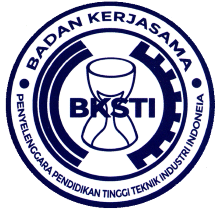Upaya Meningkatkan Kualitas Produk Bakso Berdasarkan Model Kano di CV Mett Ball Foods
(1) Teknik Industri, Universitas Indraprasta PGRI
(2) Teknik Industri, Universitas Indraprasta PGRI
(*) Corresponding Author
Abstract
The opportunity for processing food (Bakso) is so large, the intense competition between players in seizing customers requires that the customers can improve the quality of their products based on customer perceptions. This study aims to improve the quality of meatball products based on the Kano model method. The method used in this study uses the Kano method or model combined with eight dimensions of TQM quality or Garvin 1987 dimensions for the goods category. The results showed that there were six attributes belonging to the Must-be category, five attributes belonging to the One-dimensional category, three attributes belonging to the Attractive category and 16 attributes belonging to the Inddiffrent category. The quality improvement priorities that must be made in order to increase customer satisfaction are found in the One-dimensional category of B12, B14, B17, B21 and Attractive Attributes on Attributes B1, B2 and B19.
Key words : Customer Satisfaction, Canoe Model, Dimensions of quality (TQM)
Full Text:
PDF (Indonesian)References
Handayani, T., & Wahyudi, I. (2018). Uji Ph, Kadar Air Dan Mutu Mikrobiologi Bakso Di Kota Padang. Jurnal Katalisator, 3(1), 61-70.
Nurhuda, H. S., & Rochima, E. (2017). Penambahan Tepung Karaginan Terhadap Tingkat Kesukaan Bakso Ikan Manyung. Jurnal Perikanan Kelautan, 8(1).
Santoso, I., Mustaniroh, S. A., & Pranowo, D. (2018). Keakraban Produk dan Minat Beli Frozen Food: Peran Pengetahuan Produk, Kemasan, dan Lingkungan Sosial. Jurnal Ilmu Keluarga & Konsumen, 11(2), 133-144.
Khaeruroh, N., Hasiholan, L. B., & Mukeri, M. (2018). The Influence Of The Quality Of The Produk, Service Quality, Trust To The Customer Loyalty To The Customer Satisfaction As A Variable Intervening (Study In Pt Morich Indo Fashion Ungaran). Journal of Management, 4(4).
Alimudin, A., & Yoga, H. (2015). Strategi meningkatkan loyalitas pelanggan pada usaha kecil produk makanan ringan di surabaya. Sustainable Competitive Advantage (SCA), 5(1).
Rosyidah, A., Purwanti, E., Hartanto, D., Murwani, I. K., Prasetyoko, D., & Ediati, R. (2017). Penataan PKL Bebas Boraks dan Formalin Menuju Produk Unggulan Sehat dan Higienis. Qardhul hasan: media pengabdian kepada masyarakat, 3(2), 86-98.
Santi, A. U. P. (2018). Analisis Kandungan Zat Pengawet Boraks Pada Jajanan Sekolah Di Sdn Serua Indah 1 Kota Ciputat. Jurnal Holistika, 1(1).
Garvin, D. A., & Quality, W. D. P. (1984). Really Mean. Sloan management review, 25.
Mastrisiswadi, H., & Herianto, H. (2017). Analisis kebutuhan robot rehabilitasi pasien pasca stroke dengan menggunakan metode Kano. Jurnal Ilmiah Teknik Industri, 15(2), 151-156.
Sidiq, R., & Purnomo, H. (2017). Desain Spatula Ergonomis Menggunakan Pendekatan Model Kano. Jurnal Teknoin, 22(7).
Mastrisiswadi, H., & Herianto, H. (2017). Analisis kebutuhan robot rehabilitasi pasien pasca stroke dengan menggunakan metode Kano. Jurnal Ilmiah Teknik Industri, 15(2), 151-156.
Witell, L., Löfgren, M., & Dahlgaard, J. J. (2013). Theory of attractive quality and the Kano methodology–the past, the present, and the future. Total Quality Management & Business Excellence, 24(11-12), 1241-1252.
Berger, C. (1993). Kano's methods for understanding customer-defined quality. Center for quality management journal, 2(4), 3-36.
DOI: http://dx.doi.org/10.30998/joti.v1i1.3426
Refbacks
- There are currently no refbacks.









